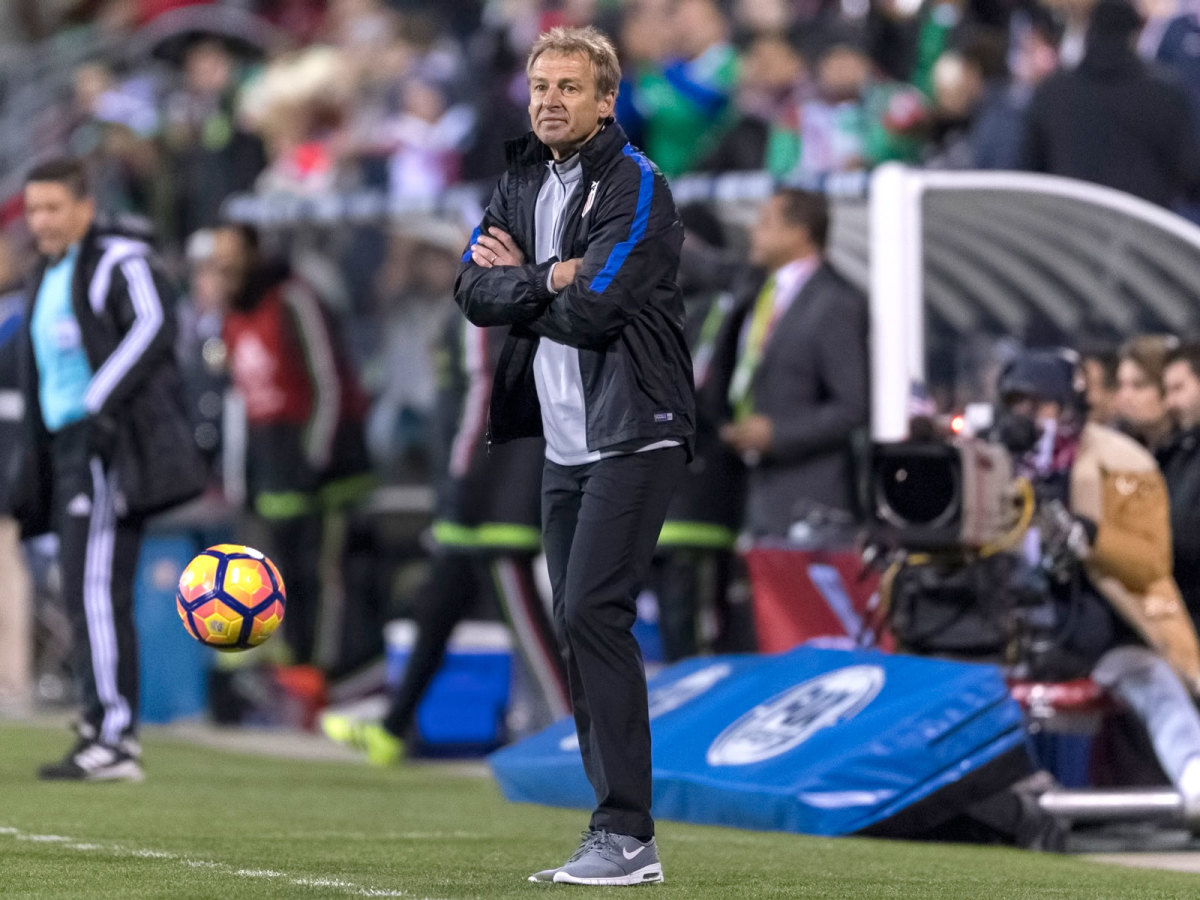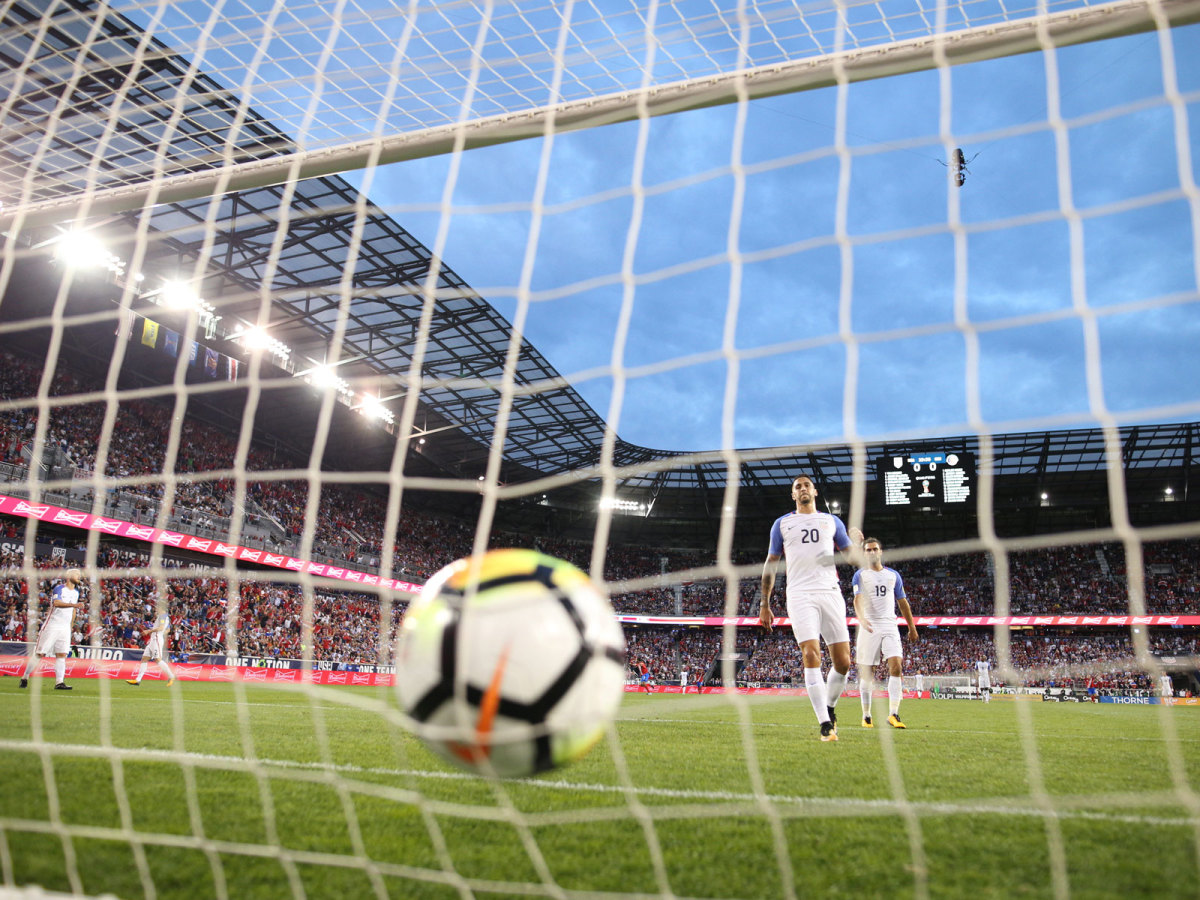Arrogance, Poor Play, Fine Margins: The Anatomy of USA's World Cup Qualifying Failure

Russia may be thousands of miles away, but on Tuesday night, the U.S. national team was mere inches from getting there. Watch the replays, if you can stomach them. It’s technically true. Clint Dempsey hit the right post with a long-range bouncer in the second half down in Trinidad. If his shot goes in, the USA almost certainly escapes with a 2-2 draw and is on its way to the World Cup. The margins on Omar Gonzalez’s early own goal were even finer. The beleaguered center back couldn’t hit that slice again if given 100 chances.
And then there was the phantom goal scored by Panama in Tuesday's 2-1 defeat of Costa Rica. Had the Guatemalan officials realized the ball never crossed the line, the USA at least would be on its way to a playoff against Australia—a few thousand miles in the opposite direction but still, mere inches away.
Inches can influence results and in turn, shape narratives. That’s certainly the case in a given game or even in a short tournament like a World Cup. And for that reason, soccer’s quadrennial global party isn’t the best litmus test for an individual country’s progress. For most participants, the whole thing lasts a couple weeks. The draw, injuries, referees and bounces all play a massive role.
USA's Haunting World Cup Qualifying Failure Emits Blame, Shock and Calls for Change
But qualifying isn’t a short tournament. It’s a two-year, 16-game grind—about half a league season—that asks questions, tests depth and resilience and exposes flaws, both personal and systemic. And after a bumbling 7-5-4 campaign that featured a coaching change and an historically inept three-win performance in CONCACAF’s Hexagonal, both the current U.S. national team and the U.S. Soccer Federation were exposed.
It’s tempting to dig deep, down to the foundation, and advocate for a total overhaul in structure, governance, philosophy and personnel. Conversations certainly must be had about all of those things and at this point, it’s hard to argue against change—especially at the top. And there’s time to have those conversations, since the American men won’t play another meaningful game for nearly two years.
But if you want to torch the system and scorch the earth, understand first that U.S. Soccer’s/soccer’s idiosyncrasies didn’t stop it from playing in the previous seven World Cups (one of which it hosted.) It’s important to isolate variables. Our system has many flaws, but it took a little bit extra to achieve what the USA managed over the past year-plus. Missing out on the 2018 World Cup was about the failure of individual men to do what a quarter century of forebears found a way to achieve. It was about poor leadership, poor planning, poor play and, yes, a few inches here or there.
How many times over the past few months did we hear a U.S. player invoke his team’s traditional reply when “backs were against the wall?” Indeed, there was an established national team tradition of responding to adversity.
Perhaps American backs are often against walls because of those aforementioned flaws in the system. But it’s also true that those do-or-die days usually brought out the best in the U.S. player. There was always enough in the tank and heart. But that attribute isn’t immutable. It doesn’t exist or persist simply because they say it does. It’s a fire that must be stoked—a culture that must be nurtured through commitment and vigilance. For some reason, this group of players folded when their backs were up against it. And on Tuesday, in the game of their lives, they were listless and inept. Meanwhile, their manager went against what had been working, ignored the obvious and made an indefensible tactical blunder. This was a choke job of historic proportions that put paid to the idea that the USA inevitably rises to the occasion. This is a team that was congratulating itself for predecessors’ accomplishments.
Landon Donovan: USA's World Cup Qualifying Ouster 'Disheartening' and 'Unacceptable'
So this failure could be measured in inches and moments, but also with a wide-angle lens and a calendar. It’s a failure of men as much as an indictment of any system (it’s worth noting that playing in MLS didn’t seem to adversely impact the men from Costa Rica, Panama and Honduras who remain in World Cup contention). These Americans stumbled where others had succeeded. And before U.S. Soccer moves forward and decides who will be along for the ride, it must determine where responsibility lies.
The USA’s five qualifying defeats were the most in a given cycle in program history. From 1980 through 2015, it lost two home qualifiers. Then it lost home games to Mexico (under Jurgen Klinsmann) and Costa Rica (under Bruce Arena) 10 months apart. The Americans finished first in the Hex in 2006, 2010 and 2014. This time they finished fifth, five points behind their previous low (17).
Why was this team so much worse?
A couple answers come to mind, and it starts with USSF president Sunil Gulati and his handpicked coaches, Klinsmann and Arena. All bear massive responsibility. Gulati was seduced by Klinsmann’s charisma and his promise of cachet and cultural change, and he realized far too late that the German’s big ideas—many of which were good—didn’t make him a decent manager on gameday. A good chunk of the USA’s identity—that backs against the wall spirit and cohesion—was stripped away by Klinsmann’s inability to establish a tactical foundation, his predilection for discomfort and division, his poor preparation and so many inscrutable decisions.
Klinsmann belonged in an office, boardroom or classroom, not on the sideline. But Gulati’s delay and misplaced faith meant the potential benefit of the former had to be sacrificed.

Gulati burdened himself and U.S. Soccer with Klinsmann’s unearned promotion and contract extension ahead of the 2014 World Cup, then waited too long to fire him once it was clear in late 2015 that the team was lost. He had no choice after Klinsmann wrecked the Hex opener against Mexico with an impromptu 3-5-2 and the subsequent 4-0 demolition in Costa Rica, during which the USA clearly quit on its coach. But significant damage had been done.
The record wasn’t the biggest problem—six points can be overcome in the Hex. The lack of time to find the right successor and recondition the team was the issue. Had Klinsmann left a year earlier, more could’ve been done to overhaul the squad. But because the USA was 0-2-0 and in desperate need of an immediate turnaround, the decision to appoint Arena—and the legendary coach’s pragmatism and reliance on veterans for a quick fix—was defensible.
No progress had been made toward identifying and grooming goalkeeper Tim Howard’s successor. If it wasn’t going to be Brad Guzan, Klinsmann could’ve decided that in early 2015 and started to commit to new candidates. Howard aged before our eyes over the past couple months. The defense continued to be an area of excessive flux, to the point where Arena’s reserve options at left and right back were the 35-year-old DaMarcus Beasley and converted attacking midfielder Graham Zusi, respectively. The same is true in the middle, where younger prospects like Matt Miazga, Matt Hedges, Cameron Carter-Vickers and others remained on the outside looking in for too long. When the stakes were highest, Arena understandably felt uncomfortable thrusting a newbie into the qualifying cauldron. But they shouldn't have been newbies by then. Injuries to the likes of DeAndre Yedlin and John Brooks hurt, and fullbacks like Eric Lichaj, Greg Garza, Justin Morrow and Timmy Chandler simply were ignored to one extent or another.
Five Biggest Heartbreaks in Recent USMNT History
The coaching change paid some immediate dividends. U.S. players lauded the breath of fresh air and appreciated Arena’s logic, planning and communication. Arena infused a bit of confidence and comfort and then added to that foundation. He’s been praised for his ability to maximize potential and chemistry and for a keen understanding of strengths and weaknesses in a given individual or group. In March, Dempsey and Christian Pulisic unloaded on hapless Honduras in a 6-0 rout. In June, we saw what appeared to be a coaching masterclass as Arena meticulously prepared for two very different games just three days apart. After easing past T&T in Denver, he deployed a group that had trained in the 3-5-2 and was able to secure a 1-1 tie in Mexico. The USA was on its way.
With the Gold Cup title secured in July, the momentum was palpable. Veterans like Dempsey, Howard, Jozy Altidore and Michael Bradley were energized and Paul Arriola emerged as a new option out wide. The margin for error remained small—this wasn’t the time to experiment with uncapped kids—but Russia was closer than ever. Gulati could probably see it from U.S. Soccer House.
Then the wheels fell off. One thing Arena seems to have in common with Klinsmann is arrogance–a belief in his own infallibility and the notion that if something occurs to him and seems like a good idea, it therefore must be one. It was clear midway through the first half in the September qualifier against Costa Rica at Red Bull Arena that Arena's 4-4-2 wasn’t working. The USA couldn’t handle the Ticos’ pressure, couldn’t establish any rhythm with the ball and couldn’t find Pulisic on the right wing.

When Klinsmann set the USA up to fail against Mexico, it took pleading from his players to force an in-game change. That didn’t appear to happen at RBA, and Costa Rica ran out 2-0 winners.
Arena said following the match that he’d been outcoached. But that’s impossible, right?
“I do that so you guys don’t have to try to be creative and actually try to figure out what happened in the game,” Arena told reporters a couple days later in Honduras. “To be honest with you, I didn’t really necessarily mean that. I just said that so you don’t have to spend any time critiquing anyone else.”
The players didn’t make plays that night at RBA. Howard and Geoff Cameron were the scapegoats in back, and the U.S. lamented the referee’s failure to intervene on its behalf on a couple close calls. But the USA was set up to fail.
With USMNT Eliminated from World Cup, Fox Must Refocus Coverage Plan
Like Klinsmann, Arena demanded too much from Bradley. The captain is a good player and should have a future with the national team, but somehow two consecutive coaches decided he’s superhuman. Klinsmann tasked Bradley with orchestrating the build-up, monitoring Jermaine Jones and playing as a No. 10—often simultaneously. Arena emptied the U.S. midfield and asked Bradley to link the back four to the attackers essentially on his own. If Bradley was that good, he’d have left Roma for Juventus, not Toronto FC. He needed to start, but he needed help. But Arena stopped calling in Benny Feilhaber and Sacha Kljestan, didn’t develop Kellyn Acosta or Cristian Roldan, didn’t use Alejandro Bedoya or Dax McCarty and thought too highly of the reticent Darlington Nagbe. The 3-5-2 that worked against Mexico was essentially abandoned. A 4-2-3-1, which would’ve allowed Pulisic to stay central while offering a bit of support to Bradley, apparently wasn’t considered.
Moving Pulisic to the middle and last week’s 4-0 win over Panama in Orlando masked the formational and foundational deficiencies. Success required everyone to have an on-day against a passive opponent. Inexplicably, Arena failed to realize the frailties of that 4-4-2 and sent the same players out against Trinidad just four days later, despite having used fresher, more prepared charges in previous away games. Dempsey, Cameron and Guzan were on the bench. Everyone had off-days, and once again, Arena took too long to accept the inevitable and make needed changes.
He left the USA’s fate tied to those inches.
